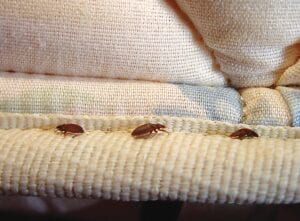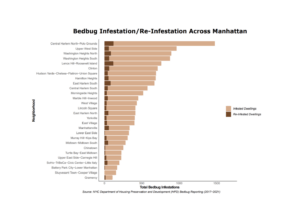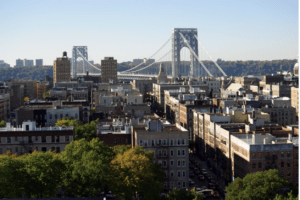
by: Luke Walsh
The COVID-19 Pandemic shut down New York City in March of 2020. Trains, buses, roads and bike lanes all were emptied across the city in an effort to stop the spread of the virus. While many people did flee for the suburbs and exurbs,, it was not the ghost town that it was alleged to be. City residents remained, albeit trapped indoors. Mental health became a major global concern during quarantine; one important factor contributing to mental health issues for residents across New York City was poor living conditions. These poor living conditions included overcrowded apartments, lack of utilities such as WiFi , and for select tenants, bedbugs.
Before analyzing the presence of bedbugs in New York City, it is integral to first analyze what bedbugs are, how they operate, and their effects on individuals’ health . Bedbugs are small nocturnal parasites that feed off of the blood of humans and animals while they sleep. Consequently, infestations often occur in homes, especially in bedrooms. The Center for Disease Control and Prevention (CDC) and the U.S. Environmental Protection Agency (EPA) issued a joint statement in 2010 regarding the prevalence and the effects of bedbugs. According to their report, bedbugs can pose a threat to physical health. To feed, bedbugs bite the host, releasing an anesthetic so the host does not wake up. People have a wide range of reactions to these bites. Some experience no effect, while others experience a mild allergic reaction resulting in itchy red bumps. In rare cases, bedbug bites induce a severe allergic reaction, anaphylaxis, that causes facial swelling, low blood pressure, and difficulty breathing that requires immediate medical intervention.
The spread of bedbugs is often difficult to contain for several reasons. Logistically, infestation is not indicative of the cleanliness of the home. Most infestations occur from migration from other infested areas, such as adjacent apartments or buildings. Additionally, bedbugs can be transferred by people entering one’s home, through purses, luggage and other upholstered items they may unexpectedly bring. Furthermore, household clutter does make it more difficult for extermination as bedbugs tend to hide during the day in small cracks and crevices of furniture, wallpaper and other material. Another particularly noteworthy cause of lack of containment is the economic strain. As mentioned before, bedbugs hide in small crevices throughout one’s home, thus extermination often requires multiple treatments. Additionally, the cost of the extermination treatments is higher than for other pests due the level of experience needed. Consequently, the persistence of bedbugs within dwellings can be incredibly burdensome economically.
The presence of bedbugs also negatively impacts mental health. Jerome Goddard, PhD and Richard de Shazo, MD published a study in The American Journal of Medicine sighting the psychological toll the presence of bedbugs had on those living in with infestations. 81% living with bedbugs reported symptoms associated with Post-Traumatic Stress Disorder (PTSD) such as paranoia, obsessive thoughts/behaviors, depression, anxiety and suicidal thoughts or actions. These physical, mental and economic strains on individuals are life altering events, and events such as the COVID-19 Pandemic only exacerbate the toll taken on victims experiencing infestation.
New York City officials are no stranger to bedbug infestations. The New York City Department of Housing Preservation and Development (HPD) classifies bedbugs as a Class B violation under the Housing and Maintenance Code, Subchapter 2, Article 4, which means that bedbugs are legally considered hazardous. If bedbugs are discovered, landlords have 30 days to correct the issue and ensure the infestation does not continue. If landlords do not cooperate, tenants can (and should) call 311, which is the citizen’s contact number for HPD. Once they call and make a complaint, HPD opens an investigation, which results in an inspector making an unannounced visit to the home. Depending on the results of the investigation, they issue a violation to the landlord requiring to have the matter resolved. Additionally, landlords or property owners are required to report infestation history of their dwelling units to the HPD, which is collected and aggregated into a public dataset.
Using the HPD’s public dataset can bring to light key facts and statistics regarding bedbug infestations across New York City. According to this dataset, which is updated regularly, there have been a total of 43, 834 reported infestations since 2017. Manhattan tops the list with 12, 701, followed by Queens with 11, 470. Brooklyn and the Bronx follow next with 10,677 and 8,556 infestations respectively. Finally, Staten Island rounds out the list with 430 infestations across the island.
The numbers can be broken down by borough, which is displayed below using RStudio, formed into a bar graph:

This information can be useful for a general sense of how many cases of bedbug infestations there are; however, it is even more useful to break down the findings by neighborhood. For the graph below, using HPD’s Bedbug Reporting Dataset, take a look at how bedbug infestations within dwellings along with re-infestation cases are spread out across the various neighborhoods of New York City’s most densely populated borough, Manhattan.

North Central Harlem tops the list with 1,357 dwellings infested dwellings, 120 of which were re-infested since 2017. Gramercy was at the bottom with 93 dwellings infested and 13 cases of re-infestation. A major question arises from these findings: why are re-infestations taking place, particularly in certain neighborhoods more than others? These are the types of questions that we must ask and answer to begin the process of lowering infestation and re-infestation numbers across the boroughs.
The greater picture of Manhattan tells a story of a forgotten physical and mental health epidemic. A neighborhood that is a good proxy for understanding this problem is Washington Heights. Broken down into northern Washington Heights garnering 806 infested dwellings with 88 re-infestations, and southern Washington Heights having 814 infested dwellings with 63 re-infestations, the total infested dwelling count is 1,620 with 151 re-infestations since 2017. This means that Washington Heights, alone, accounts for 3.7% of all bedbug infestations across the entirety of New York City.

There are multiple factors that contribute to this high rate of infestation. As stated, economic strains are placed on individuals facing bedbug infestation. While in New York City the burden of extermination legally falls on the landlords, the reality is, even with HPD issued violations, the infestations go untreated, as validated by the prevalence of cases. Additionally, going through through the HPD investigation process takes quite a bit of time from complaint to violation order and from violation order to when the tenant can take legal action, during which the infestation continues to grow. If legal action is needed to rectify the problem, this financial, mental, and time burden falls on the tenant, as only a small percentage qualify for free legal aid from the government in these situations.
Cover Image Source: Orkin